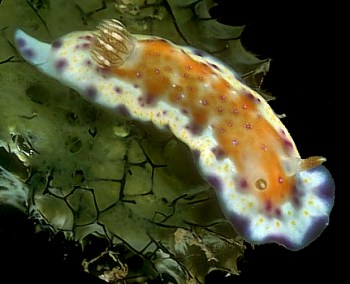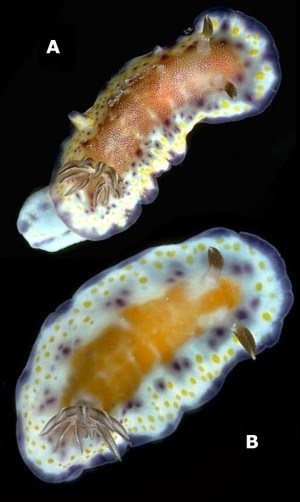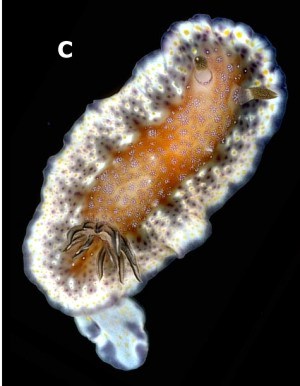
Chromodoris collingwoodi
Rudman, 1987
Order: NUDIBRANCHIA
Suborder: DORIDINA
Superfamily: EUDORIDOIDEA
Family: Chromodorididae
DISTRIBUTION
Western Pacific.
PHOTO
UPPER RIGHT: Split Solitary Is., 15m, off Coffs Harbour, NSW, Australia, March 1988, on food sponge. 17mm long alive.
LOWER: A, Récif de l'Infernet, in lagoon, off Koumac, New Caledonia, 20°35.8'S, 164°12.7'E, 9 m, inner side of reef, 15 October 1993, 38mm long alive. B,C. Récif de l'Infernet, in lagoon, off Koumac, New Caledonia, 20°37.1'S, 164°14.7'E, 1 m, diverse substrate, 22 October 1993, 2 specimens (23 & 44mm long alive).
PHOTOS: Bill Rudman.
The mantle has a purple border of irregular width. Inside this is a broad white region surrounding a large central translucent reddish or orange-brown patch extending from in front of the rhinophores to just behind the gills. There are many bright yellow spots scattered over the outer half of the white region. Also in the white region are dark purple spots, usually larger than the yellow ones but not always, and they are more numerous on the inner half. The dark spots are found not only in the white region but also in the central region where they are obscured by the orange-brown
pigmentation and appear as shadowy brown regions. One characteristic feature of the central brown region is the scattering of fine white specks all over. In some specimens in which parts of the red-brown region are very pale, the white specks are concentrated over the shadowy brown spots. There is considerable variation in the intensity of the reddish brown central patch as can be seen in the photos on this page.
The rhinophore stalk is translucent and the club is a dark reddish brown with white specks along the edge of the lamellae and a white tip. The gills are sub-quadrangular in section. They are translucent with a dark brown, almost black, line down the two edges of each of the outer and inner sides, the pigmentation extending a little out on to both sides of the gill lamellae.
The underside of the mantle is white with a purple edge, as dorsally, and there is a purple spot on each oral tentacle. The foot is white with a row of bright yellow spots all around the edge. Posteriorly there are some purple patches and sometimes more widespread yellow spots.
This species has been confused with C. aureopurpurea Collingwood. In fact it differs markedly in colour from C. aureopurpurea, in which the mantle is white with yellow spots, except at the edge, where there is a submarginal row of dark purple spots and a diffuse purple band right at the edge. In C. collingwoodi there is an irregular purple border and then a broad region in which there are small yellow and larger purple spots. The central part of the mantle is usually a translucent red- brown with brownish spots and fine white specks. Another species with a similar colour pattern is C. tennentana. In that species the border is bluish purple and the white region inside it has yellow spots. It has a large orange-brown central patch as in C. collingwoodi but differs in having large purple spots each surrounded by a white ring and these are restricted to the central part of the mantle with an orange-brown background colour.
Reference:
•Rudman, W.B. (1987) The Chromodorididae (Opisthobranchia: Mollusca) of the Indo-West Pacific: Chromodoris epicuria, C. aureopurpurea, C. annulata, C. coi and Risbecia tryoni colour groups. Zoological Journal of the Linnean Society, 90: 305-407.
PHOTOS: LOWER: A, Récif de l'Infernet, in lagoon, off Koumac, New Caledonia, 20°35.8'S, 164°12.7'E, 9 m, inner side of reef, 15 October 1993, 38mm long alive.
B,C. Récif de l'Infernet, in lagoon, off Koumac, New Caledonia, 20°37.1'S, 164°14.7'E, 1 m, diverse substrate, 22 October 1993, 2 specimens (23 & 44mm long alive).
PHOTOS: Bill Rudman.


Rudman, W.B., 2000 (May 21) Chromodoris collingwoodi Rudman, 1987. [In] Sea Slug Forum. Australian Museum, Sydney. Available from http://www.seaslugforum.net/factsheet/chrocoll
Related messages
-
Chromodoris collingwoodi feeding & breeding
From: Leanne and David Atkinson, March 23, 2010 -
Re: Chromodoris collingwoodi feeding observations
From: Bruce Wilkie, June 21, 2007 -
Chromodoris collingwoodi feeding observations
From: Leanne & David Atkinson, January 31, 2007 -
Chromodoris collingwoodi laying eggs
From: Leanne & David Atkinson, January 12, 2006 -
Chromodoris collingwoodi from sthrn Queensland
From: Gary Cobb, August 10, 2004 -
Chromodoris collingwoodi egg mass
From: Nerida Wilson, February 19, 2004 -
Chromodoris collingwoodi feeding
From: Leanne & David Atkinson, February 17, 2004 -
Chromodoris collingwoodi feeding
From: Leanne & David Atkinson, January 15, 2004 -
Re: Chromodoris collingwoodi from South China
From: Mabel Fang , October 16, 2003 -
Chromodoris collingwoodi from South China Sea
From: Mabel Fang, October 13, 2003 -
Chromodoris collingwoodi from Port Stephens
From: Dave Harasti, June 13, 2003 -
Chromodoris collingwoodi from Bali
From: Stuart Hutchison, February 19, 2002 -
Chromodoris collingwoodi from Hong Kong
From: Leslie Chan, July 13, 2001 -
Chromodoris collingwoodi from Hong Kong
From: Bill Rudman & Brian Darvell, July 13, 2001 -
Re: Chromodoris collingwoodi feeding
From: Jeff Goddard, June 24, 2000 -
Chromodoris collingwoodi feeding
From: Mary Jane Adams, June 22, 2000 -
Chromodoris collingwoodi from Sydney
From: A. Lumnitzer & D. Piotrowska, May 22, 2000
